List of states with nuclear weapons
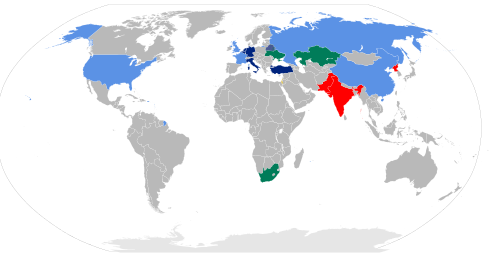
There are eight sovereign states that have successfully detonated nuclear weapons. Five are considered to be "nuclear-weapon states" (NWS) under the terms of the Nuclear Non-Proliferation Treaty (NPT). In order of acquisition of nuclear weapons these are: the United States, the Russian Federation (successor state to the Soviet Union), the United Kingdom, France, and China. Nations that are known or believed to possess nuclear weapons are sometimes referred to as the nuclear club.
Since the NPT entered into force in 1970, three states that were not parties to the Treaty have conducted nuclear tests, namely India, Pakistan, and North Korea. North Korea had been a party to the NPT but withdrew in 2003. Israel is also widely believed to have nuclear weapons, though it maintains a policy of deliberate ambiguity regarding this, and is not known definitively to have conducted a nuclear test.[1]
South Africa has the unique status of a nation that developed nuclear weapons but has since disassembled its arsenal before joining the NPT.
Statistics
The following is a list of states that have admitted the possession of nuclear weapons, the approximate number of warheads under their control, and the year they tested their first weapon. This list is informally known in global politics as the "Nuclear Club."[2] With the exception of Russia and the United States (which have subjected their nuclear forces to independent verification under various treaties) these figures are estimates, in some cases quite unreliable estimates. Also, these figures represent total warheads possessed, rather than deployed.[clarification needed] In particular, under the SORT treaty thousands of Russian and U.S. nuclear warheads are inactive in stockpiles awaiting processing. The fissile material contained in the warheads can then be recycled for use in nuclear reactors.
From a high of 68,000 active weapons in 1985, there are now some 4,100 active nuclear warheads and some 17,300 total nuclear warheads in the world in 2013.[3] Many of the decommissioned weapons were simply stored or partially dismantled, not destroyed.[4]
| Country | Warheads active/total[nb 1] | Date of first test | CTBT status[5] |
|---|---|---|---|
| The five nuclear-weapon states under the NPT | |||
| 2,150 / 7,700[3] | 16 July 1945 ("Trinity") | Signatory | |
| 1,800 / 8,500[3] | 29 August 1949 ("RDS-1") | Ratifier | |
| 160 / 225[3] | 3 October 1952 ("Hurricane") | Ratifier | |
| 290 / 300[3] | 13 February 1960 ("Gerboise Bleue") | Ratifier | |
| n.a. / 250[3] | 16 October 1964 ("596") | Signatory | |
| Non-NPT nuclear powers | |||
| n.a. / 90–110[3] | 18 May 1974 ("Smiling Buddha") | Non-signatory | |
| n.a. / 100–120[3] | 28 May 1998 ("Chagai-I") | Non-signatory | |
| n.a. / <10[3] | 9 October 2006[6] | Non-signatory | |
| Undeclared nuclear powers | |||
| n.a. / 60-200[3][7] | Unknown (possibly 22 September 1979) | Signatory | |
Five nuclear-weapon states under the NPT
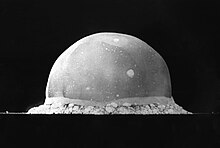
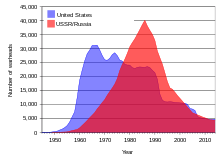
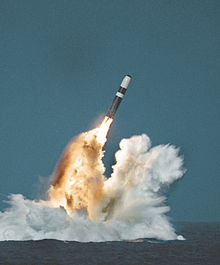
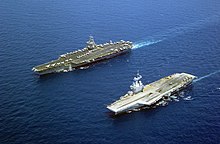
- United States
- The United States developed the first atomic weapons during World War II in co-operation with the United Kingdom and Canada as part of the Manhattan Project, out of the fear that Nazi Germany would develop them first. It tested the first nuclear weapon in 1945 ("Trinity"), and remains the only country to have used nuclear weapons against another nation, during the atomic bombings of Hiroshima and Nagasaki. It was the first nation to develop the hydrogen bomb, testing an experimental prototype in 1952 ("Ivy Mike") and a deployable weapon in 1954 ("Castle Bravo"). Throughout the Cold War it continued to modernize and enlarge its nuclear arsenal, but from 1992 on has been involved primarily in a program of Stockpile stewardship.[8][9][10] The U.S. nuclear arsenal contained 31,175 warheads at its Cold War height (in 1966).[11] During the Cold War the United States built approximately 70,000 nuclear warheads, more than all other nuclear-weapon states combined. [12][13]
- Soviet Union / Russian Federation
- The Soviet Union tested its first nuclear weapon ("RDS-1") in 1949, in a crash project developed partially with espionage obtained during and after World War II (see: Soviet atomic bomb project). The Soviet Union was the second nation to have developed and tested a nuclear weapon. The direct motivation for their weapons development was to achieve a balance of power during the Cold War. It tested its first megaton-range hydrogen bomb ("RDS-37") in 1955. The Soviet Union also tested the most powerful explosive ever detonated by humans, ("Tsar Bomba"), with a theoretical yield of 100 megatons, intentionally reduced to 50 when detonated. After its dissolution in 1991, the Soviet weapons entered officially into the possession of the Russian Federation.[14] The Soviet nuclear arsenal contained some 45,000 warheads at its peak (in 1986); the Soviet Union built about 55,000 nuclear warheads since 1949.[13]
- United Kingdom
- The United Kingdom tested its first nuclear weapon ("Hurricane") in 1952. Britain had provided considerable impetus and initial research for the early conception of the atomic bomb, aided by the presence of refugee scientists working in British laboratories who had fled the continent. It collaborated closely with the United States and Canada during the Manhattan Project, but had to develop its own method for manufacturing and detonating a bomb as U.S. secrecy grew after 1945. The United Kingdom was the third country in the world after the United States and Soviet Union to develop and test a nuclear weapon. Its programme was motivated to have an independent deterrent against the Soviet Union, while also maintaining its status as a great power. It tested its first hydrogen bomb in 1957 (Operation Grapple), making it the third country to do so after the United States and Soviet Union.[15][16] The UK maintained a fleet of V bomber strategic bombers and ballistic missile submarines (SSBNs) equipped with nuclear weapons during the Cold War. It currently maintains a fleet of four 'Vanguard' class ballistic missile submarines equipped with Trident II missiles. The British government announced a replacement to the current system to take place between 2007-2024.
- France
- France tested its first nuclear weapon in 1960 ("Gerboise Bleue"), based mostly on its own research. It was motivated by the Suez Crisis diplomatic tension vis-à-vis both the Soviet Union and the Free World allies United States and United Kingdom. It was also relevant to retain great power status, alongside the United Kingdom, during the post-colonial Cold War (see: Force de frappe). France tested its first hydrogen bomb in 1968 ("Opération Canopus"). After the Cold War, France has disarmed 175 warheads with the reduction and modernization of its arsenal that has now evolved to a dual system based on submarine-launched ballistic missiles (SLBMs) and medium-range air-to-surface missiles (Rafale fighter-bombers). However new nuclear weapons are in development [citation needed] and reformed nuclear squadrons were trained during Enduring Freedom operations in Afghanistan. [citation needed] In January 2006, President Jacques Chirac stated a terrorist act or the use of weapons of mass destruction against France would result in a nuclear counterattack.[17] France signed the Nuclear Non-Proliferation Treaty in 1992.[18]
- China
- China tested its first nuclear weapon device ("596") in 1964 at the Lop Nur test site. The weapon was developed as a deterrent against both the United States and the Soviet Union. Two years later, China had a fission bomb capable of being put onto a nuclear missile. It tested its first hydrogen bomb ("Test No. 6") in 1967, a mere 32 months after testing its first nuclear weapon (the shortest fission-to-fusion development known in history).[19] The country is currently thought to have had a stockpile of around 240 warheads, though because of the limited information available, estimates range from 100 to 400.[20][21][22] China is the only NPT nuclear-weapon state to give an unqualified negative security assurance due to its "no first use" policy.[23][24] China signed the Nuclear Non-Proliferation Treaty in 1992.[18]
Other states declaring possession of nuclear weapons
This section needs to be updated. (June 2009) |

- India
- India is not a party to the Nuclear Non-Proliferation Treaty. India tested what it called a "peaceful nuclear explosive" in 1974 (which became known as "Smiling Buddha"). The test was the first test developed after the creation of the NPT, and created new questions about how civilian nuclear technology could be diverted secretly to weapons purposes (dual-use technology). India's secret development caused great concern and anger particularly from nations, such as Canada, that had supplied its nuclear reactors for peaceful and power generating needs. It appears to have been primarily motivated as a general deterrent, as well as an attempt to project India as a regional power.
- Indian officials rejected the NPT in the 1960s on the grounds that it created a world of nuclear "haves" and "have-nots," arguing that it unnecessarily restricted peaceful activity (including peaceful nuclear explosives), and that India would not accede to international control of their nuclear facilities unless all other countries engaged in unilateral disarmament of their own nuclear weapons. The Indian position has also asserted that the NPT is in many ways a neo-colonial regime designed to deny security to post-colonial powers.[25] Even after its 1974 test, India maintained that its nuclear capability was primarily "peaceful", but between 1988 and 1990 it apparently weaponized two dozen nuclear weapons for delivery by air.[26] In 1998 India tested weaponized nuclear warheads ("Operation Shakti"), including a thermonuclear device.[27]
- In July 2005, U.S. President George W. Bush and Indian Prime Minister Manmohan Singh announced plans to conclude an Indo-US civilian nuclear agreement.[28] This came to fruition through a series of steps that included India’s announced plan to separate its civil and military nuclear programs in March 2006,[29] the passage of the United States-India Peaceful Atomic Energy Cooperation Act by the U.S. Congress in December 2006, the conclusion of a U.S.-India nuclear cooperation agreement in July 2007,[30] approval by the IAEA of an India-specific safeguards agreement,[31] agreement by the Nuclear Suppliers Group to a waiver of export restrictions for India,[32] approval by the U.S. Congress[33] and culminating in the signature of U.S.-India agreement for civil nuclear cooperation[34] in October 2008. The U.S. State Department said it made it "very clear that we will not recognize India as a nuclear-weapon state".[35] The United States is bound by the Hyde Act with India and may cease all cooperation with India if India detonates a nuclear explosive device. The US had further said it is not its intention to assist India in the design, construction or operation of sensitive nuclear technologies through the transfer of dual-use items.[36] In establishing an exemption for India, the Nuclear Suppliers Group reserved the right to consult on any future issues which might trouble it.[37] As of early 2013, India was estimated to have had a stockpile of around 90–110 warheads.[3]
- Pakistan
- Pakistan also is not a party to the Nuclear Non-Proliferation Treaty. Pakistan covertly developed nuclear weapons over decades, beginning in the late 1970s. Pakistan first delved into nuclear power after the establishment of its first nuclear power plant near Karachi with equipment and materials supplied mainly by western nations in the early 1970s. Pakistani Prime Minister Zulfiqar Ali Bhutto promised in 1965 that if India can build nuclear weapons then Pakistan would too, "even if we have to eat grass." The United States continued to certify that Pakistan did not possess nuclear weapons until 1990, when sanctions were imposed under the Pressler Amendment, requiring a cutoff of U.S. economic and military assistance to Pakistan.[38] It is believed that Pakistan has possessed nuclear weapons since the mid-1980s.[39] In 1998, Pakistan conducted its first six nuclear tests at the Chagai Hills, in response to the five tests conducted by India a few weeks before.
- In 2004, the Pakistani metallurgist A.Q. Khan, a key figure in Pakistan's nuclear weapons program, confessed to heading an international black market ring involved in selling nuclear weapons technology. In particular, Khan had been selling gas centrifuge technology to North Korea, Iran, and Libya. Khan denied complicity by the Pakistani government or Army, but this has been called into question by journalists and IAEA officials, and was later contradicted by statements from Khan himself.[40] As of early 2013, Pakistan was estimated to have had a stockpile of around 100–120 warheads.[3]
- North Korea
- North Korea was a party to the Nuclear Non-Proliferation Treaty, but announced a withdrawal on January 10, 2003, after the United States accused it of having a secret uranium enrichment program and cut off energy assistance under the 1994 Agreed Framework. In February 2005 the North Koreans claimed to possess functional nuclear weapons, though their lack of a test at the time led many experts to doubt the claim. However, in October 2006, North Korea stated that due to growing intimidation by the USA, it would conduct a nuclear test to confirm its nuclear status. North Korea reported a successful nuclear test on October 9, 2006 (see 2006 North Korean nuclear test). Most U.S. intelligence officials believe that North Korea did, in fact, test a nuclear device due to radioactive isotopes detected by U.S. aircraft; however, most agree that the test was probably only partially successful.[41] The yield may have been less than a kiloton, which is much smaller than the first successful tests of other powers; boosted fission weapons may have an unboosted yield in this range, which is sufficient to start deuterium-tritium fusion in the boost gas at the center; the fast neutrons from fusion then ensure a full fission yield. North Korea conducted a second, higher yield test on 25 May 2009 (see 2009 North Korean nuclear test) and a third test with still higher yield on 12 February 2013 (see 2013 North Korean nuclear test).
Other states believed to possess nuclear weapons
- Israel
- Israel is widely believed to be the sixth country in the world to develop nuclear weapons, having assembled crude, but likely operational, nuclear weapons in 1967.[42] Israel is not a party to the NPT. Israel engages in strategic ambiguity, saying it would not be the first country to "introduce" nuclear weapons into the region, but refusing to otherwise confirm or deny a nuclear weapons program or arsenal. This policy of "nuclear opacity" has been interpreted as an attempt to get the benefits of deterrence with a minimum political cost.[42][43] In 1968, the Israeli Ambassador to the United States, Yitzhak Rabin, affirmed to the United States State Department that Israel would "not be the first to introduce nuclear weapons into the Middle East." Upon further questioning about what "introduce" meant in this context, however, he said that "he would not consider a weapon that had not been tested a weapon," and affirmed that he did not believe that "an unadvertised, untested nuclear device" was really "a nuclear weapon." He also agreed, however, that an "advertised but untested" device would be considered "introduction." This has been interpreted to mean that official Israeli policy was that the country could possess a nuclear weapon without technically "introducing" it, so long as it did not test it, and as long as it was "unadvertised".[44][45]
- There is extensive evidence Israel has nuclear weapons or a near-ready nuclear weapons capability. There is also speculation that Israel may have tested a nuclear weapon along with South Africa in 1979, but this has never been confirmed, and interpretation of the Vela Incident is controversial. The stated purpose of the Negev Nuclear Research Center near Dimona is to advance basic nuclear science and applied research on nuclear energy.[46]
- In 1986, a former Dimona technician, Mordechai Vanunu, disclosed extensive information about the nuclear program to the British press, including photographs of the secret areas of the nuclear site, some of which depicted nuclear weapons cores and designs. Vanunu gave detailed descriptions of lithium-6 separation required for the production of tritium, an essential ingredient of fusion-boosted fission bombs, as well as information about the rate of plutonium production. Vanunu's evidence was vetted by experienced technical experts before publication, and is considered to be among the strongest evidence for the advanced state of the Israeli nuclear weapons program.[43][47] According to the Natural Resources Defense Council and the Federation of American Scientists, Israel likely possesses around 75–200 nuclear weapons.[7][48] In May 2008, former US President Jimmy Carter stated that "Israel has 150 or more [nuclear weapons]."[49]
Nuclear weapons sharing
| Country | Air base | Custodian | Warheads |
|---|---|---|---|
| Kleine Brogel | 52d Fighter Wing | 10~20 | |
| Büchel | 52d Fighter Wing | 10~20 | |
| Ghedi Torre | 6th Fighter Wing | 10~20 | |
| Aviano | 31st Fighter Wing | 50 | |
| Volkel | 52d Fighter Wing | 10~20 | |
| Incirlik | 39th Air Base Wing | 60~70 | |
| Total | 150~200 | ||
- Belgium, Germany, Italy, Netherlands, Turkey
- Under NATO nuclear weapons sharing, the United States has provided nuclear weapons for Belgium,[51] Germany,[51] Italy, the Netherlands,[51] and Turkey[51] to deploy and store.[52] This involves pilots and other staff of the "non-nuclear" NATO states practicing, handling, and delivering the U.S. nuclear bombs, and adapting non-U.S. warplanes to deliver U.S. nuclear bombs. U.S. nuclear weapons were also deployed in Canada until 1984, and in Greece until 2001 for nuclear sharing purposes.[53]
- Members of the Non-Aligned Movement have called on all countries to "refrain from nuclear sharing for military purposes under any kind of security arrangements."[54] The Institute of Strategic Studies Islamabad (ISSI) has criticized the arrangement for allegedly violating Articles I and II of the NPT, arguing that "these Articles do not permit the NWS to delegate the control of their nuclear weapons directly or indirectly to others."[55] NATO has argued that the weapons' sharing is compliant with the NPT because "the U.S. nuclear weapons based in Europe are in the sole possession and under constant and complete custody and control of the United States."[56]
States formerly possessing nuclear weapons
Nuclear weapons have been present in many nations, often as staging grounds under control of other powers. However, in only one instance has a nation given up nuclear weapons after being in control of them; in most cases this has been because of special political circumstances. The fall of the Soviet Union, for example, left several former Soviet republics in possession of nuclear weapons.

- South Africa
- South Africa produced six nuclear weapons in the 1980s, but disassembled them in the early 1990s. In 1979, there was a putative detection of a covert nuclear test in the Indian Ocean, and it has long been speculated that it was possibly a test by South Africa, perhaps in collaboration with Israel, though this has never been confirmed (see Vela Incident). South Africa signed the Nuclear Non-Proliferation Treaty in 1991.[57]
Former Soviet countries
- Belarus had 81 single warhead missiles stationed on its territory after the Soviet Union collapsed in 1991. They were all transferred to Russia by 1996. In May 1992, Belarus acceded to the Nuclear Non-Proliferation Treaty.[58]
- Kazakhstan inherited 1,400 nuclear weapons from the Soviet Union, and transferred them all to Russia by 1995. Kazakhstan has since acceded to the Nuclear Non-Proliferation Treaty.[59]
- Ukraine has acceded to the Nuclear Non-Proliferation Treaty. Ukraine inherited about 5,000 nuclear weapons when it became independent from the Soviet Union in 1991, making its nuclear arsenal the third-largest in the world.[60] By 1996, Ukraine had voluntarily disposed of all nuclear weapons within its territory, transferring them to Russia.[61]
See also
| Nuclear weapons |
|---|
 |
| Background |
| Nuclear-armed states |
|
- Comprehensive Test Ban Treaty
- Historical nuclear weapons stockpiles and nuclear tests by country
- Nuclear disarmament
- Nuclear latency — states who have the capability of producing nuclear weapons quickly but have not done so
- Nuclear proliferation — states who are accused of attempting to acquire nuclear weapons
- Nuclear war
- Nuclear terrorism
- Nuclear-weapon-free zone
Notes
- ^ All numbers are estimates from the Federation of American Scientists, unless other references are given. The latest update was in December 2012. If differences between active and total stockpile are known, they are given as two figures separated by a forward slash. If specifics are not available (n.a.), only one figure is given. Stockpile number may not contain all intact warheads if a substantial amount of warheads are scheduled for but have not yet gone through dismantlement; not all "active" warheads are deployed at any given time. When a range of weapons is given (e.g., 0–10), it generally indicates that the estimate is being made on the amount of fissile material that has likely been produced, and the amount of fissile material needed per warhead depends on estimates of a country's proficiency at nuclear weapon design.
References
- ^ Harding, Luke (2006-12-12). "Calls for Olmert to resign after nuclear gaffe Israel and the Middle East | Guardian Unlimited". London: Guardian. Retrieved 2009-05-15.
- ^ "Nuclear club," Oxford English Dictionary: "nuclear club n. the nations that possess nuclear weapons." The term's first cited usage is from 1957.
- ^ a b c d e f g h i j k l "Federation of American Scientists: Status of World Nuclear Forces". Fas.org. Early 2013. Retrieved 2013-06-04.
{{cite web}}: Check date values in:|date=(help) - ^ Webster, Paul (July/August 2003). "[1]," The Guardian.
- ^ "Status of Signature and Ratification of the Comprehensive Test Ban Treaty". Retrieved 13 January 2012.
- ^ "U.S.: Test Points to N. Korea Nuke Blast". The Washington Post. October 13, 2006.
- ^ a b There are a wide range of estimates as to the size of the Israeli nuclear arsenal. Most sources put 200 as the highest possible value. One source in 1997 suggested "more than 400", but this has not been echoed in later analysis. For a compiled list of estimates, see Avner Cohen, The Worst-Kept Secret: Israel's bargain with the Bomb (Columbia University Press, 2010), Table 1, page xxvii and page 82.
- ^ Hansen, Chuck (1988). U.S. nuclear weapons: The secret history. Arlington, TX: Aerofax. ISBN 0-517-56740-7.
- ^ Hansen, Chuck (1995). The Swords of Armageddon: U.S. nuclear weapons development since 1945. Sunnyvale, CA: Chukelea Publications.
- ^ Stephen I. Schwartz, ed., Atomic Audit: The Costs and Consequences of U.S. Nuclear Weapons Since 1940 (Washington, D.C.: Brookings Institution Press, 1998).
- ^ "Fact Sheet: Increasing Transparency in the U.S. Nuclear Weapons Stockpile" (PDF). U.S. Department of Defense. 3 May 2010. Retrieved 31 August 2013.
- ^ [2]
- ^ a b Robert S. Norris and Hans M. Kristensen, "Global nuclear stockpiles, 1945-2006," Bulletin of the Atomic Scientists 62, no. 4 (July/August 2006), 64-66.
- ^ Holloway, David (1994). Stalin and the bomb: The Soviet Union and atomic energy, 1939-1956. New Haven, CT: Yale University Press. ISBN 0-300-06056-4.
- ^ Gowing, Margaret (1974). Independence and deterrence: Britain and atomic energy, 1945-1952. London: Macmillan. ISBN 0-333-15781-8.
- ^ Arnold, Lorna (2001). Britain and the H-bomb. Basingstoke: Palgrave. ISBN 0-312-23518-6.
- ^ France 'would use nuclear arms' (BBC, January 2006)
- ^ a b Treaty on the Non-Proliferation of Nuclear Weapons, United Nations Office for Disarmament Affairs.
- ^ John Wilson Lewis and Xue Litai, China Builds the Bomb (Stanford, Calif.: Stanford University Press, 1988). ISBN 0-8047-1452-5
- ^ [3][4][5]
- ^ Norris, Robert S. and Hans M. Kristensen. "Chinese nuclear forces, 2006," Bulletin of the Atomic Scientists 62:3 (May/June 2006): 60-63.
- ^ Lewis, Jeffery. "The ambiguous arsenal," Bulletin of the Atomic Scientists 61:3 (May/June 2005): 52-59.
- ^ "No-First-Use (NFU)". Nuclear Threat Initiative. Archived from the original on 2010-01-25.
- ^ "Statement on security assurances issued on 5 April 1995 by the People's Republic of China" (Document). United Nations. 6 April 1995. S/1995/265.
{{cite document}}: Unknown parameter|accessdate=ignored (help); Unknown parameter|url=ignored (help) - ^ George Perkovich, India's Nuclear Bomb: The Impact on Global Proliferation (Berkeley: University of California Press, 1999), 120-121, and 7.
- ^ George Perkovich, India's Nuclear Bomb: The Impact on Global Proliferation (Berkeley: University of California Press, 1999), 293–297.
- ^ "India's Nuclear Weapons Program: Operation Shakti". 1998. Retrieved 2006-10-10.
- ^ "Joint Statement Between President George W. Bush and Prime Minister Manmohan Singh". Whitehouse.gov. Retrieved 2009-05-15.
- ^ Implementation of the India-United States Joint Statement of July 18, 2005: India’s Separation Plan
- ^ U.S.-India Civil Nuclear Cooperation Initiative – Bilateral Agreement on Peaceful Nuclear Cooperation
- ^ "IAEA Board Approves India-Safeguards Agreement". Iaea.org. Retrieved 2009-05-15.
- ^ Statement on Civil Nuclear Cooperation with India
- ^ Congressional Approval of the U.S.-India Agreement for Cooperation Concerning Peaceful Uses of Nuclear Energy (123 Agreement)
- ^ Secretary of State Condoleezza Rice and Indian Minister of External Affairs Pranab Mukherjee At the Signing of the U.S.-India Civilian Nuclear Cooperation Agreement
- ^ Interview With Undersecretary of State for Arms Control and International Security Robert Joseph, Arms Control Today, May 2006.
- ^ Was India misled by America on nuclear deal?, Indian Express.
- ^ ACA: Final NSG Statement
- ^ "Case Studies in Sanctions and Terrorism: Pakistan". Iie.com. Retrieved 2009-05-15.
- ^ NTI Pakistan Profile, retrieved 22 April 2012.
- ^ See A.Q. Khan: Investigation, dismissal, confession, pardon and aftermath, for citations and details.
- ^ "CIA's Hayden: North Korea Nuke Test 'Was a Failure'". Newsmax.com. 2007-03-28. Retrieved 2009-05-15.
- ^ a b NTI Israel Profile Retrieved July 12, 2007.
- ^ a b Avner Cohen (2010). The Worst-Kept Secret: Israel's bargain with the Bomb. Columbia University Press.
- ^ Memcon, "Negotiations with Israel - 4F and Advanced Weapons," November 8, 1968 and Memcon, "Negotiations with Israel - F4 and Advanced Weapons," November 12, 1968, both part of National Security Archive Electronic Briefing Book No. 189, "Israel Crosses the Threshold" (April 28, 2006)
- ^ Avner Cohen and William Burr, "The Untold Story of Israel's Bomb," Washington Post, April 30, 2006; B01.
- ^ "Nuclear Research Center NEGEV - NRCN". Israel Atomic Energy Commission. Retrieved February 1, 2012.
- ^ "Vanunu 'wanted to avert holocaust'". BBC News. May 29, 2004.
- ^ Israel's Nuclear Weapons, Federation of American Scientists (August 17, 2000)
- ^ "Israel 'has 150 nuclear weapons'". BBC News. 2008-05-26.
- ^ Hans M. Kristensen (26 June 2008). "Status of U.S. Nuclear Weapons in Europe". Federation of American Scientists. Retrieved 10 November 2012.
- ^ a b c d Murphy, Philip D. (12 November 2009). "NATIONAL SECURITY ADVISOR HEUSGEN ON AFGHANISTAN, MIDDLE EAST, IRAN, DETAINEES, RUSSIA, NUKES AND BALKANS". Cablegate. Wikileaks. Archived from the original on 30 November 2010. Retrieved 30 November 2010.
a withdrawal of nuclear weapons from Germany and perhaps from Belgium and the Netherlands could make it very difficult politically for Turkey to maintain its own stockpile
- ^ "Berlin Information-center for Transatlantic Security: NATO Nuclear Sharing and the N.PT - Questions to be Answered". Bits.de. Retrieved 2009-05-15.
- ^ Hans M. Kristensen (February 2005). "U.S. Nuclear Weapons in Europe" (Document). Natural Resources Defense Council.
{{cite document}}: Unknown parameter|accessdate=ignored (help); Unknown parameter|url=ignored (help) - ^ Statement on behalf of the non-aligned state parties to the Treaty on the Non-Proliferation of Nuclear Weapons, 2 May 2005
- ^ ISSI - NPT in 2000: Challenges ahead, Zafar Nawaz Jaspal, The Institute of Strategic Studies, Islamabad
- ^ NATO's Positions Regarding Nuclear Non-Proliferation, Arms Control and Disarmament and Related Issues, NATO
- ^ Nuclear Weapons Program (South Africa), Federation of American Scientists (May 29, 2000).
- ^ Belarus Special Weapons, Federation of American Scientists
- ^ Kazakhstan Special Weapons, Federation of American Scientists
- ^ Ukraine Special Weapons, GlobalSecurity.org
- ^ Ukraine Special Weapons, Federation of American Scientists
External links
- Archive of Nuclear Data - List of warheads by country
- Globalsecurity.org – World Special Weapons Guide
- The Nuclear Weapon Archive
- Nuclear Notebook from Bulletin of the Atomic Scientists
- U.S. Nuclear Weapons in Europe: A review of post-Cold War policy, force levels, and war planning NRDC, February 2005
- Online NewsHour with Jim Lehrer:Tracking Nuclear Proliferation
- History of Nuclear Proliferation For more on the history of nuclear proliferation see the Woodrow Wilson Center's Nuclear Proliferation International History Project website.

